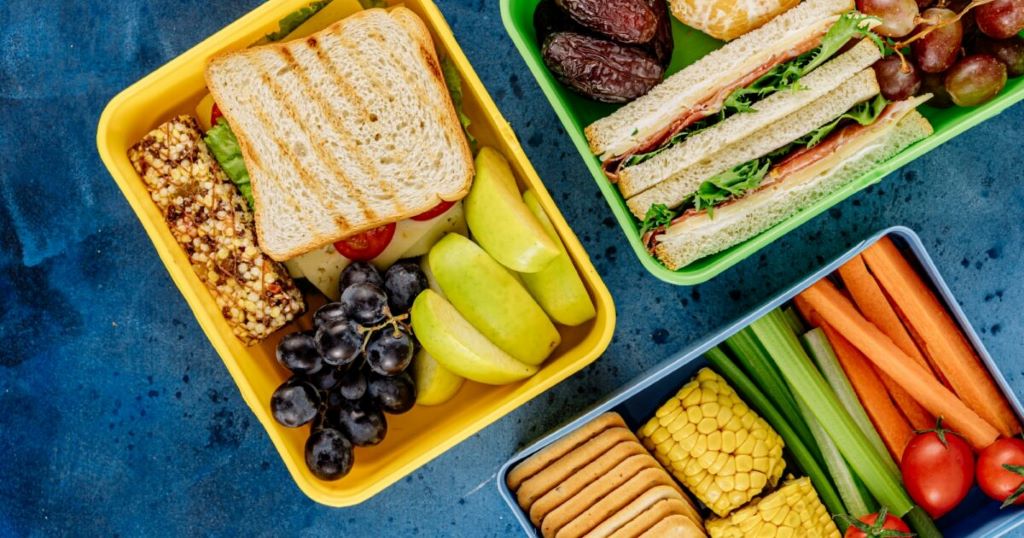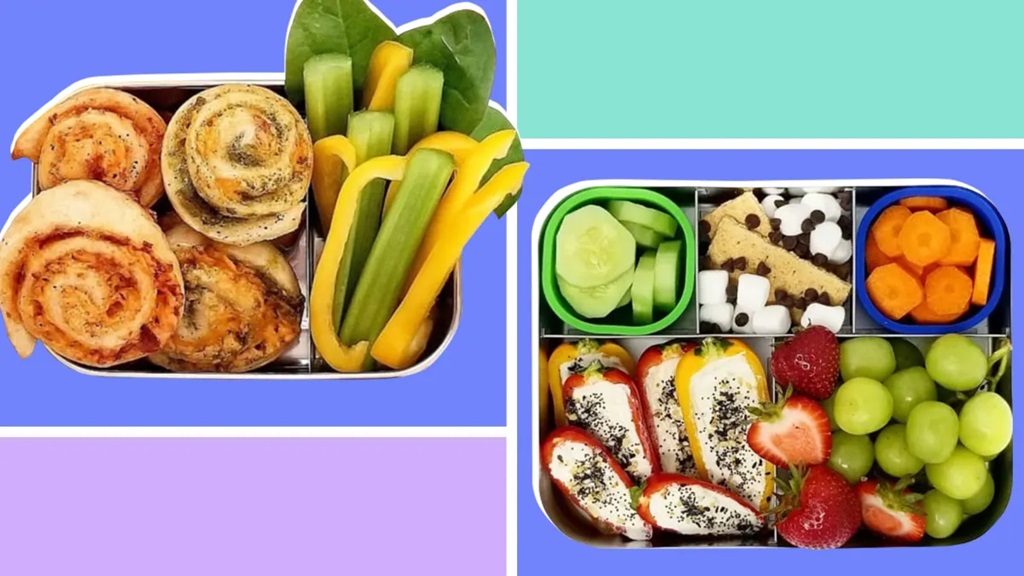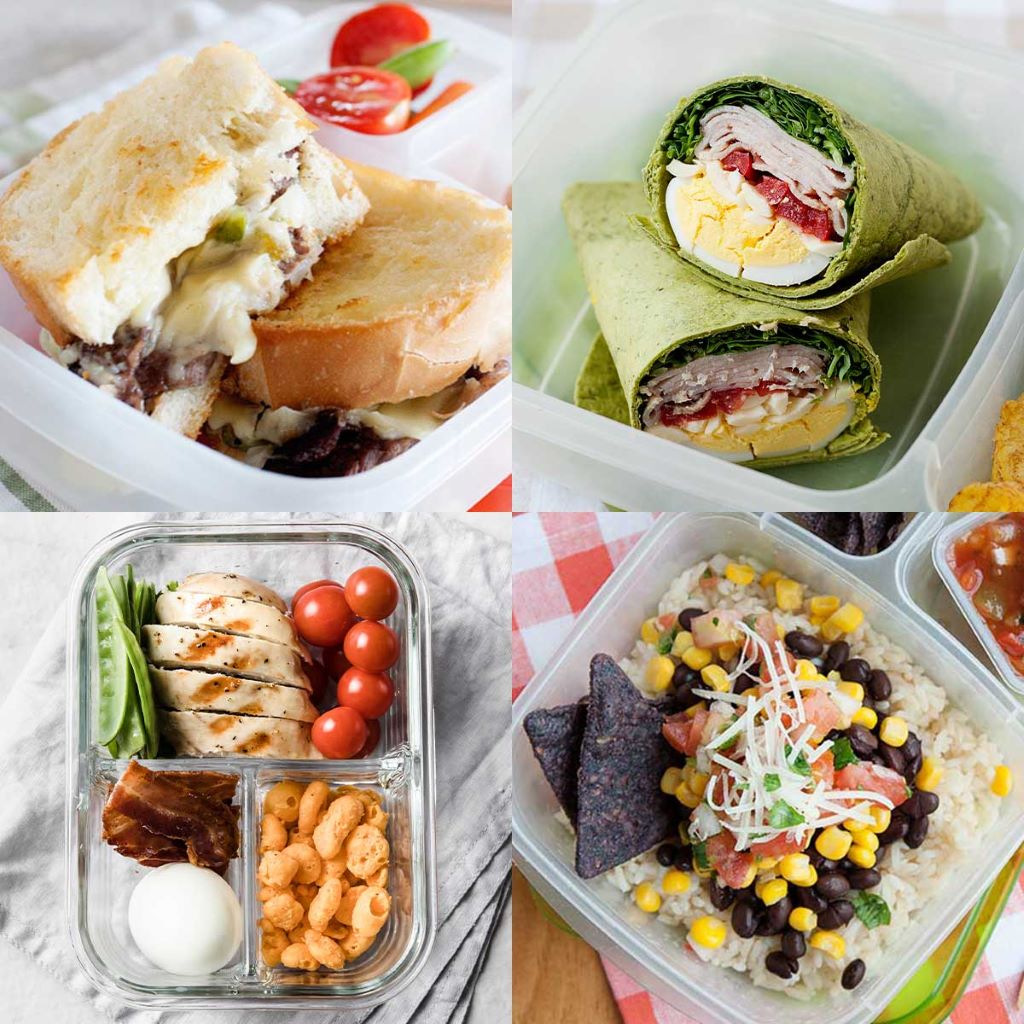
22 Dec Healthy Kids Lunch Ideas for School
Packing nutritious lunches that your kids will eat can seem daunting. With picky eaters, busy schedules, and cafeteria peer pressure, coming up with healthy yet appetizing lunch ideas is no small feat. However, having a game plan and getting a bit creative can help make packing school lunches less stressful. This comprehensive guide aims to provide tips, tricks, and healthy kids lunch ideas for school of all ages. We’ll cover nutritional recommendations, time-saving shortcuts, budget-friendly suggestions, and easy-to-pack meal and snack concepts. With a little planning and preparation, you’ll be packing lunches like a pro in no time!
Kids Lunch Ideas for School Nutritional Guidelines

When coming up with healthy school lunch ideas, it helps to have an understanding of basic nutritional guidelines for kids. The USDA provides recommendations for calorie ranges, protein, whole grains, fruits, vegetables, dairy, etc. Here is an overview:
Calories
- Ages 4-8 years: 1,200-1,400 calories
- Ages 9-13 years: 1,400-2,000 calories
- Ages 14-18 years: 1,800-2,400 calories
Of course individual needs vary, but these serve as a decent estimate. Focus on providing nutrient-dense calories through wholesome foods over empty calories.
Grains
- Ages 4-8 years: 5 oz equivalent
- Ages 9-12 years: 6 oz equivalent
- Ages 13-18 years: 8 oz equivalent
Aim for at least half to come from whole grain sources like whole wheat bread, brown rice, oats, etc. Limit refined grains like white bread or treats to smaller portions.
Protein
- Ages 4-8 years: 19-34 grams
- Ages 9-13 years: 34-52 grams
- Ages 14-18 years: 46-77 grams
Lean protein helps satisfy hunger and provides lasting energy. Chicken, turkey, beans, eggs, fish, yogurt and cheese are all nutritious options.
Fruits
- Ages 4-8 years: 1 to 1 1⁄2 cups
- Ages 9-18 years: 1 1⁄2 to 2 cups
Fruits pack vitamins, minerals, antioxidants and fiber. Offer fresh, frozen, dried or canned varieties.
Vegetables
- Ages 4-8 years: 1 to 2 cups
- Ages 9-18 years: 2 1⁄2 to 3 cups
Aim for an assortment of colorful veggies. Offer both raw and cooked options when possible.
Dairy
- Ages 4-8 years: 2 1⁄2 cups
- Ages 9-18 years: 3 cups
Dairy products like milk, yogurt and cheese provide protein and bone-building calcium. Choose low-fat or fat-free options.
Use these USDA guidelines as you craft nutritious lunch ideas for your back-to-schoolers. An all-inclusive meal might have:
- Entree with lean protein and fiber (sandwich, pasta, soup)
- Fruit and veggie sides
- Dairy food (cheese, milk, yogurt)
- Whole grain options (whole wheat bread, brown rice)
While meeting nutrition goals is important, snacks and the occasional treat are part of a healthy, balanced eating pattern too. With a well-rounded, moderate approach, packing healthy lunches for your kids can totally be doable!
Time-Saving Tips
Between school drop-offs, work commutes, grocery runs, practices and errands, days can get packed. Finding extra time for school lunch preparation may sound impossible some mornings. However, with just a bit of planning, you can take the chaos out of lunch packing. Here are some helpful time-saving strategies:
Prep Ahead
Dedicate 30-60 minutes over the weekend to handle some of the preparation for the coming week:
- Wash and chop vegetables and fruit. Store in containers for easy grabbing.
- Portion out snacks like nuts, crackers and cheese.
- Cook grains like brown rice or quinoa for quick grain bowls.
- Bake chicken breasts to use in various entrees.
Having prepped ingredients makes throwing together lunches so much simpler. You’ll thank yourself come Monday morning!
Make-Ahead Meals
Designate an afternoon or evening to prepare make-ahead meals to have on hand:
- Assemble healthy sandwiches and wraps. Wrap individually and store in the fridge or freezer.
- Portion cooked lentils, beans or lean ground meat into containers to use later in the week.
- Mix together salad dressing ingredients. Store in a jar rather than buying pre-made dressing.
Preparing dishes ahead of time helps you pull ingredients together quickly each morning.
Involve Your Kids
Enlist your children to help prepare their lunches. Kids are more likely to eat foods they helped make. Giving them ownership in the process also teaches valuable cooking skills! Have them help with age-appropriate tasks like:
- Spreading nut butter on bread
- Building wraps or sandwiches
- Portioning out fruits, veggies and snacks into baggies
- Mixing up homemade trail mix combinations
- Decorating lunch bags and containers
Making healthy lunches can become a fun family activity when the kids get involved!
Streamlining the lunch packing routine helps everything run more smoothly on busy school days. Allow time on weekends to grocery shop and prep. Designate a night or two for batch cooking make-ahead items. Get the kids engaged in the food prepping process when possible too.
Budget-Friendly Tips

Eating healthy doesn’t have to drain your wallet. With a little savvy meal planning and grocery shopping, you can pack nutritious school lunches on a budget. Keep these money-saving suggestions in mind:
Buy in Bulk
Purchase non-perishable staples in bulk at big box stores like Costco. Items like whole grain crackers, granola bars, nut butters and canned beans tend to cost less when buying larger quantities. Split up bulk packages into single-serving portions when you get home.
Seek Out Sales
Check weekly circulars from grocery stores for deals on fresh produce, eggs, cheese, yogurt and other lunch items. Stock up on sale priced goods to use throughout the coming weeks. Purchase extra perishables to freeze for later as well.
Shop in Season
Buy in-season fruits and veggies when they tend to be more affordably priced. For example, berries are cheapest in the summer and apples peak in the fall. Serve seasonal produce while it’s readily available and budget friendly.
Cook Once, Eat Twice
When cooking grains, proteins or entree items, make extra to use later in the week. For example, roast a double batch of chicken breasts, cook a big pot of chili or prepare a 9×13 pan of enchiladas. Having pre-made leftovers eliminates additional cooking.
Embrace Beans and Lentils
Beans and lentils offer an extremely economical way to add plant-based protein into meals. Canned options work well for quick lunches too. Chickpeas, black beans and green lentils pack a nutritional punch at a fraction of the cost of pricier protein sources.
Try New Versions
Buy store brand, generic or alternative versions of popular lunch items. Selection varies by store, but think along the lines of alternative nut butters, cheese slices, yogurt cups, crackers, bars and bread. You can find quality products for fewer dollars.
Drink Water
Skip buying beverage options and have kids fill reusable water bottles at home. Instill healthy hydration habits while saving money long term. Add fresh fruit slices or mint leaves to infuse flavor if desired.
With just a little intentionality, you can design healthy, satisfying school lunches that won’t break the bank. Prioritize nutritious whole foods over convenience items when possible and get creative to keep costs reasonable.
Easy-to-Pack Lunch Ideas
When deciding what to pack for nutritious school lunches, aim for items that travel well and don’t require last minute assembly. Busy mornings mean ready-to-grab foods are key! Consider these easy transport ideas:
Sandwiches and Wraps
Sandwiches and wraps make excellent portable options and endlessly adapt to please all preferences. Play around with various combinations of protein, veggies, cheese and condiments wrapped in whole grain bread, tortillas or lettuce leaves:
- Turkey + Swiss + Lettuce Wrap
- Ham + Cheddar + Mustard + Whole Wheat Bread
- Egg Salad + Spinach Wrap
- Chicken Salad + Tomato + Pita Pocket
- Peanut Butter + Banana + Honey Wheat Bread
Savory Muffins
Hide veggies inside tasty quick breads, frittatas and veggie-laden muffins. Try recipes starring ingredients like:
- Spinach
- Carrots
- Broccoli
- Sweet potato
- Bell peppers
- Zucchini
- Onion
Mix in cheese, herbs and spices to amp up flavor. These hand-held snacks pack well and make high-nutrition choices.
Quesadillas
Loaded quesadillas offer melty cheese deliciousness along with lean fillings. Fill a whole grain tortilla with precooked ingredients like black beans, shredded chicken, scrambled eggs or sautéed veggies. After warming through, slice into wedges that kids can dip into sides like salsa, Greek yogurt or guacamole.
Pizza Packs
Assemble personalized pizza kits featuring whole grain English muffins, pitas or bagels as the crust. Top with tomato sauce, veggies, cheese and cooked meat as desired. Transport crust and toppings separately, allowing kids to construct their pizzas at lunchtime.
Soup Containers
Invest in wide-mouth thermoses to transport steaming soups, stews and chilis. Hearty cooked grains with lean protein and vegetables simmered in broth makes a cradling choice for cooler days. Send crackers alongside.
Pasta Salads
Chill fun short pasta shapes or couscous tossed with a medley of add-ins like roasted veggies, olives, salami, chickpeas and feta or mozzarella. The Italian-style flavors develop even more overnight! Heartier shapes like rotini and penne hold their texture best.
Lettuce Cups
Scoop tuna/chicken/egg salad or grain bowls into lettuce leaves for an easy no-utensil-required container. Kids can enjoy the crispy veggie vessel alongside other lunch items or as the main feature.
Sheet Pan Meals
One pan dinners simplify preparation for family meals…and packable lunches! Arrange seasoned proteins and veggies tossed in oil on a baking sheet. Roast until done and portion into lunch containers throughout the week. Some winning flavor combos include:
- Chicken sausage + potatoes + green beans
- Ground turkey + sweet potatoes + zucchini
- White fish + squash + cherry tomatoes
- Steak strips + broccoli + cauliflower
The options are endless for sheet pan meals that transport well and taste amazing.
When deciding what to make for lunches, opt for items that pack neatly and don’t require final assembly. Sandwiches, wraps, hand-held muffins and single-serve pizzas work beautifully. Heartier picks like soups, pasta salads and grain bowls hold up well too. Whip up family-sized sheet pan meals to have ingredients ready to pack.
Lunch Sides and Snacks
A balanced lunch features filling mains along with nutrients-dense sides, snacks and treats. Rely on these transport-friendly options to round out lunches and please picky appetites:
Fruits
Fruits offer vitamins, antioxidants, fiber and hydration. Fresh, frozen, dried and canned varieties all work. Send fruits whole, sliced or skewed for easy eating. Berries, grapes, bananas, mandarin oranges, applesauce and raisins pack well. Include a small ice pack if needed.
Vegetables
Raw, roasted or steamed veggies provide important nutrients. Try grape tomatoes, sugar snap peas, baby carrots, broccoli florets, cucumber slices, sweet pepper strips or avocado chunks. Send healthy dips like hummus, bean dip, nut butter or ranch on the side.
Yogurt
Probe or spoonable yogurt styles provide protein, calcium and probiotics. Flavored, vanilla and fruit-filled options appeal to kids’ preferences. Sweeten plain yogurt with a drizzle of honey if desired. Add granola or fresh berries for bonus crunch and nutrients.
Cheese
Cheese offerings like mozzarella string cheese, Babybel rounds or cheese cubes make handy high-protein snacks. Pair with whole grain crackers for a balanced nibble.
Trail Mix
Homemade or store-bought no-sugar-added trail mixes with nuts, seeds, dried fruit and whole grain cereal make tasty high-energy snacks. Let kids create their perfect custom blends!
Popcorn
Whole grain popcorn furnishes a lighter crunchy snack option. Make it fresh or look for no-added-salt pre-popped versions. Send individual bags alongside flavor shakers of nutritional yeast, chili powder or Parmesan cheese for topping.
Crackers
Made from enriched wheat or whole grains, crispy crackers pair well with other lunch additions. Opt for low-sodium versions alongside dips, smears, sandwiches and more.
Fun Sides
Cute crispy starches, veggie fries and snackable sides inject fun into lunches. Try roasted sweet potato or zucchini fries, beet chips, savory black bean puffs or quinoa bites. Balance less-healthy options with ample nutrition in other areas.
Get creative with sides, snacks, fruits and veggies to make lunches more appealing. Let kids pick their own items from various categories listed above so they enjoy lunchtime.
Satisfying Yet Healthy Sweet Treats

While packing primarily wholesome foods, make room for sweet snacks and desserts in moderation. When kids know a lunch treat is coming, they feel more satisfied. Here are nutritious ways to incorporate something sweet:
Fresh Fruit
Nature’s candy offers amazing flavor and nutrition. Skewer pineapple, grapes, berries and bananas for a fruit kabob. Serve apples with almond butter or plain Greek yogurt for dipping. Citrus wedges sprinkled with cinnamon make a bright treat too.
Fruit Leather or Fruit Snacks
Stash pouches of pure fruit leathers or bars without added sugars or gels. Apple, mixed berry, peach and strawberry tend to be kid-preferred flavors. For bonus nutrition, look for options sneaking in veggies too!
Veggie or Zucchini Bread
Quick bread loaves flavored with carrots, zucchini, pumpkin or sweet potato deliver natural sweetness along with hidden veggies. Slice mini squares to tuck into lunch boxes.
Energy Bites
These no-bake cookie dough lookalikes are simple to whip up. Mix together nut butter, oats, seeds, honey and chocolate chips if desired. Chill overnight, then shape into balls for a protein and fiber-rich snack on the go.
Yogurt Parfaits
Layer vanilla or fruit-flavored yogurt with berries, sliced bananas, granola and a drizzle of honey in plastic parfait cups. The sweet crunchy combo feels like an extra-special treat.
Frozen Fruit Pops
Blend or puree fruit into juice, then pour into molds. Add yogurt for creaminess. Mix in nut butter or seeds for a protein punch too. Insert sticks and freeze overnight for fruity ice pops to grab from the freezer as kids head out the door.
Don’t deprive kids of something sweet in their lunch. Find ways to incorporate nourishing foods like fresh fruits that provide natural sugars. Then, round out the meal with smaller treats made from wholesome real-food ingredients.
Special Diet Accommodations
While planning school lunches, adapt to accommodate your child’s unique dietary needs or restrictions. Fortunately, creatively swapping a few elements allows you to work around limitations.
Gluten Free
Many bread, grains and starches contain gluten. Substitute with gluten-free options when packing sandwiches, wraps, muffins and sides:
- Gluten-free bread
- Corn or brown rice tortillas
- Quinoa flakes
- Corn pasta salad
- Sweet potato muffins
Use gluten-free all-purpose flour blend for baked goods like energy bites and zucchini bread. Stock up on snacks labeled gluten-free when available too.
Dairy Free
For children avoiding cow’s milk, opt for plant-based milk alternatives like almond milk, coconut milk or oat milk. Seek out dairy-free yogurt options made from coconut milk or almond milk as well. Instead of regular cheese slices, try vegan nut-based cheese replacements. Always read labels since milk proteins hide in many processed foods.
Vegetarian
Center lunches around hearty plant-based proteins like beans, lentils, tofu, edamame and nuts. Some easy swaps include:
- Black bean burger instead of hamburger
- Tofu veggie stir fry rather than chicken
- Lentil sloppy joe filling in place of loose meat
- Walnut lentil meatballs substitute for beef
Vegetarian lunch options prove delicious, budget-friendly and environmentally-conscious. Embrace eating more veggies and wholesome plant foods!
Nut Allergies
For kids with peanut, tree nut or seed allergies, carefully inspect labels on all packaged foods. Omit nut butter sandwiches and trail mixes made with higher allergen nuts. Sunflower seed butter, soy nut butter or seed/nut-free WOWButter make safer alternatives. Provide allergen-free dippers like pretzel crisps over crackers too. Remind children to refrain from trading food with friends.
Accommodating special diets or restrictions adds another layer of complexity to packing lunches. But with simple ingredient swaps and heightened label-reading awareness, you can adapt most menu concepts. Reach out to teachers too regarding protocols for safeguard handling of allergens among students. Prioritize your child’s safety and inclusion.
Eco-Friendly Lunch Packing Tips
Packing nutritious school lunches generates waste from disposable bags, utensils and water bottles over time. But going green doesn’t mean sacrificing convenience or nutrition! Follow these tips to reduce your family’s lunchtime environmental impact:
Use Reusable Containers
Invest in reusable containers in different sizes rather than relying on disposable zip-top baggies. Look for durable plastic food storage containers, silicone bins, stainless steel tiffin’s or cloth snack sacks. Label each piece to prevent mix-ups and simplify cleaning.
Bring Reusable Water Bottles
Rather than packing disposable water bottles or juice pouches, send refillable water bottles daily. Opt for stainless steel over plastic to avoid BPAs and microplastics migrating into liquids. Add lemon slices or fruit infusers to flavored the water if desired.
Embrace Lunch Boxes
Swap flimsy disposable lunch sacks for roomy reusable lunch boxes, bento boxes or backpacks. Prioritize insulated designs to help foods stay hot/cold for hours. Many feature compartments to organize a complete lunch. Stylish patterns appeal to kids too!
Use Washable Utensils
Equip kids with small reusable forks, spoons and food picks stored in their lunch kits. Metal, silicone or durable plastic options last for years, eliminating the need for throw-away sporks and bags daily.
Pack Cloth Napkins
Reduce paper napkin waste by supplying fabric napkins for little hands and faces. Bandana-style kerchiefs, cotton napkins or microfiber cloths launder well. Designate a mini wet/dry bag for storing soiled napkins until washing. Consider adding a handkerchief too!
Recycle When Possible
If periodically relying on disposable products, choose recyclable over non-recyclable. For example, wax paper bags, aluminum foil, paper towels and #1 PETE plastic containers commonly get recycled. Confirm local guidelines and teach children appropriate sorting once at school.
With some upfront investment into reusable lunch gear, going green no longer requires major sacrifice or hassle. Teach little ones sustainable habits while keeping nutrition a priority. Saving the planet and feeding healthy kids can totally happen simultaneously!

Putting It All Together
Constructing balanced school lunches that nourish kids’ bodies and minds requires a little forethought. But having healthy ingredients prepped along with reliable lunch ideas takes the headache out of daily packing.
Follow basic nutritional guidelines as you assemble entrees, fruits, veggies, snacks and occasional treats. Get ahead on weekends by grocery shopping and handling certain preparation tasks. Store make-ahead meal components to mix and match all week long too.
Adapt lunch items as needed to accommodate special diets and food intolerances present. Go the extra mile to ensure safe handling when life-threatening allergies exist.
Aim to pack lunches focusing mainly on whole food nourishment over heavily processed convenience fare when possible. But don’t shy away from embracing modern shortcuts to make your job easier sometimes. Wholesome yet realistic is the goal!
Equip kids with cool lunch boxes filled with delicious fuel to take on their busy days. Include helpful tools like reusables containers, napkins, forks and water bottles to minimize waste too. Fostering independence through teaching kids to self-serve their own lunches also pays off in the long run.
Approaching the lunch packing routine with intention helps set your children up for success. Not to mention, saves your sanity amidst the chaos of work and school schedules. Stay flexible, get creative and don’t stress over perfection. Arm kids with the energy they need while balancing nutrition, convenience and fun. Then, breathe easy knowing you’ve handled yet another meal over the course of this beautiful messy journey called parenthood. Go you!
FAQs
How can I get my picky eater to eat healthy lunches?
Have kids help prep their lunches and let them make choices between healthy options for a sense of control. Keep trying new flavors in moderation alongside preferred foods. Model enjoying variety yourself too! Portion smaller samples of unfamiliar items to reduce pressure and waste. Over time, continue expanding horizons by gradually incorporating novel textures, temperatures and global cuisine. Remain patient and positive.
What are easy vegetarian school lunch ideas?
Some simple plant-based lunch options include bean burritos, hummus wraps with roasted veggies, cheese quesadillas, pasta or grain bowls topped with lentils, veggie pizza pockets, chickpea salad sandwiches, veggie chili and black bean enchilada bake. Round out with fresh fruits, vegetables, nuts, seeds and dairy or non-dairy milk or yogurt if included in diet.
Should I pack a cold lunch or warm lunch?
Both cold and warm lunches work well, so offer variety! Cold lunches stay safe unrefrigerated for hours when packed with sufficient insulation and ice packs. Freezable thermoses maintain temperatures on hot soups, pastas and leftovers. Let child’s preferences and lunchroom microwaving logistics help determine the best week-by-week options.
What food safety practices should I follow when meal prepping lunches?
When batch cooking make-ahead meals, chill items quickly in shallow containers. Store cooked foods in airtight containers once cooled, keeping proteins separate from produce. Refrigerate perishables within 1-2 hours and freeze longer-term items right away. When reheating, ensure foods reach safe minimum internal temperatures. Transport hot items in insulated containers. Provide ice packs for cold foods.
How can I reduce waste from my kid’s school lunches?
Use reusable containers over disposable baggies and zip-top bags. Send a refillable water bottle rather than juice boxes or pouches. Invest in a durable lunch box with sections to eliminate the need for one-time-use sack lunches. Provide washable forks/spoons and cloth napkins that launder instead of paper products. Teach kids to recycle disposable items accepted at their school when unavoidable. Lead by example!
Conclusion
Packing healthy yet satisfying school lunches fuels kids up to take on busy days of learning and play. Following sound nutritional guidelines as you plan entrees, sides and snacks ensures proper nourishment. Getting creative with make-ahead meals along with grab-and-go items streamlines the packing process tremendously too.
Invest in reusable lunch containers, water bottles and accessories to make eco-friendly packing simple. Acclimate picky eaters over time by continuing to offer new flavors repeatedly with positivity. Occasional treats keep morale high, so bake up nutritious goodies using wholesome ingredients.
Remain flexible day-to-day based on schedules, what’s on hand and your energy levels as a parent. Cut yourself slack – no need to reinvent the wheel every morning! Start simply then build a repertoire of reliable lunches that kids look forward to.
The most important part happens right before they walk out the door. Make eye contact, give an encouraging pep talk, sneak in a hug and wave goodbye warmly. The food nourishes their body, but your unconditional love fuels their spirit. When it comes to school lunch ideas, choosing nutrient-rich options like brown rice over regular pasta adds an extra layer of wholesome goodness to the ultimate recipe for raising healthy, happy kids.

Sorry, the comment form is closed at this time.